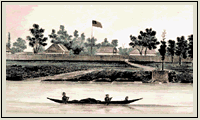1840s
 The Queen married in February 1840 and embarked on two decades of happiness with her consort, Prince Albert of Saxe-Coburg-Gotha. Her first child, also Victoria, was born later that year, and before the 1840s were over she had six children, including Edward, Prince of Wales,her successor to the throne.
The Queen married in February 1840 and embarked on two decades of happiness with her consort, Prince Albert of Saxe-Coburg-Gotha. Her first child, also Victoria, was born later that year, and before the 1840s were over she had six children, including Edward, Prince of Wales,her successor to the throne.
 The Queen made her first Railway journey in 1842, the same year James Douglas sailed on the steamship Beaver The Cityto the site recommended by William McNeill as the future depot for the Hudson's Bay Company. Douglas's reasons for choosing the site were clear. Here was a safe harbour, abundant timber close by and a potential water power site for a grist and saw mill. What sets Camosack apart, he told John McLoughlin in his official report, is "a range of plains nearly six miles square containing a great extent of valuable tillage and pasture land equally well adapted for the plough or feeding stock. It was this advantage and distinguishing feature of Camosack, which no other part of the coast possesses ... which led me to chase [choose] a site for the establishment at that place." Douglas was less restrained in his description of the site to hisfriend James Hargrave, wherein the size of the prairie grew. In this letter of February 1843, hecalled the site "a perfect Eden":
The Queen made her first Railway journey in 1842, the same year James Douglas sailed on the steamship Beaver The Cityto the site recommended by William McNeill as the future depot for the Hudson's Bay Company. Douglas's reasons for choosing the site were clear. Here was a safe harbour, abundant timber close by and a potential water power site for a grist and saw mill. What sets Camosack apart, he told John McLoughlin in his official report, is "a range of plains nearly six miles square containing a great extent of valuable tillage and pasture land equally well adapted for the plough or feeding stock. It was this advantage and distinguishing feature of Camosack, which no other part of the coast possesses ... which led me to chase [choose] a site for the establishment at that place." Douglas was less restrained in his description of the site to hisfriend James Hargrave, wherein the size of the prairie grew. In this letter of February 1843, hecalled the site "a perfect Eden":
The extent of this singular district is about 9 miles square, the size of a goodly Parish in the land of cakes; the surface undulating into hill and dale and rendered strikingly picturesque by groupes of fir and oaks...
Douglas consulted with the Lekwammen, who welcomed the arrival of the Fort as a wayto enhance their wealth in their own economy. The Lekwammen supplied the building material for the fort in exchange for trade goods.
Douglas originally called the fort Camosack, later Fort Albert, to honour the Queen's consort, and then to Fort Victoria in honour of the young Queen and in expectation of creation of a major centre at this site.
Queen Victoria took note of establishment named after her in 1849. She made it the capital of the new colony of Vancouver Island, the first formal establishment of British Imperial authority on the west coast of the Americas.